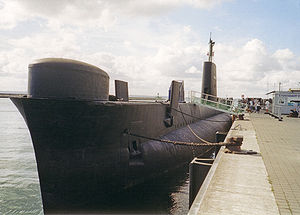
Back Třída Oberon Czech Oberon-Klasse German Clase Oberon Spanish زیردریایی کلاس اوبرون Persian Oberon-luokka Finnish Classe Oberon French Classe Oberon Italian オベロン級潜水艦 Japanese Kapal selam Kelas Oberon Malay Okręty podwodne typu Oberon Polish
 HMS Otus moored at a dock in 2002.
| |
| Class overview | |
|---|---|
| Name | Oberon class |
| Builders | |
| Operators | |
| Preceded by | Porpoise class |
| Succeeded by | Upholder class and Collins class |
| In commission | 1960–2000 |
| Completed | 27 |
| Retired | 27 |
| Preserved | 8 complete, 3 partial, 1 awaiting conversion |
| General characteristics for Royal Navy submarines | |
| Type | Attack/Patrol submarine |
| Displacement |
|
| Length | 295.2 ft (90.0 m) |
| Beam | 26.5 ft (8.1 m) |
| Draught | 18 ft (5.5 m) |
| Propulsion |
|
| Speed | |
| Range | 10,350 nautical miles (19,170 km; 11,910 mi) at surface cruising speed |
| Test depth | 650 ft (200 m) |
| Complement |
|
| Sensors and processing systems |
|
| Electronic warfare & decoys | MEL Manta UAL or UA4 radar warning[citation needed] |
| Armament |
|
| Notes |
|
The Oberon class was a ship class of 27 British-designed submarines operated by five nations. They were designed as a follow-on from the Porpoise class; physical dimensions were the same but stronger materials were used in hull construction and improved equipment was fitted.[3]
The Oberons operated during the Cold War, with duties including surveillance, tracking of other ships and submarines, delivery and retrieval of special forces personnel and serving as targets for anti-submarine training. Submarines of the class were in service until 2000.
The Oberon class was arguably the best conventional submarine class of its time,[4] with a reputation for remarkable quietness. The quietness of the Oberon vessels enabled them to operate into the late 20th century until replaced by newer classes such as the Collins and Victoria classes in Australia and Canada, respectively.
The submarines were built between 1957 and 1978 by four shipyards: Cammell Laird (4), Chatham Dockyard (6), Scotts Shipbuilding and Engineering Company (11) and Vickers-Armstrongs (6).[5] Thirteen of the submarines were operated by the Royal Navy, six by the Royal Australian Navy, three by the Brazilian Navy, three by the Royal Canadian Navy/Canadian Forces Maritime Command (plus two ex-Royal Navy boats later acquired for non-commissioned roles), and two by the Chilean Navy.[5]
- ^ a b Sharpe (ed.), Jane's Fighting Ships, 1996–97, pgs. 23, 54, 86, 104
- ^ Chant, A Compedium of Armaments and Military Hardware, pp. 167–8
- ^ Chant, Christopher (2005). Submarine Warfare Today: The World's Deadliest Underwater Weapons Systems. Wigston: Silverdale Books. p. [page needed]. ISBN 1-84509-158-2. OCLC 156749009.
- ^ Cite error: The named reference
brown&moorewas invoked but never defined (see the help page). - ^ a b Moore, John, ed. (1977). Jane's Fighting Ships 1977–78. Jane's Fighting Ships (80th ed.). London: Jane's Yearbooks. pp. 26, 44, 63, 81, 490. ISBN 0531032779. OCLC 18207174.